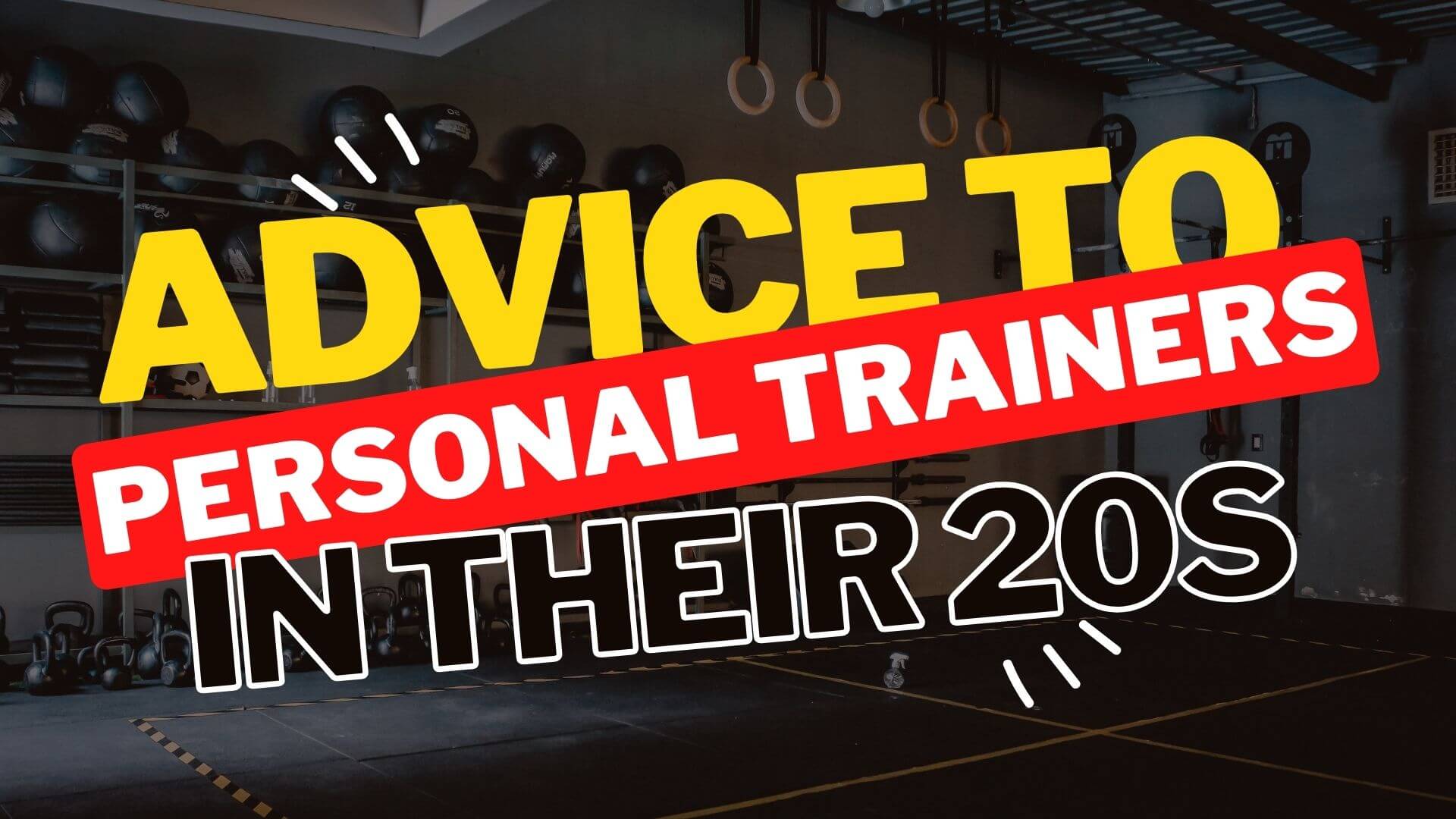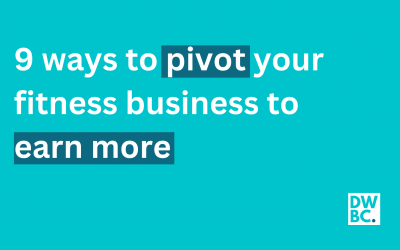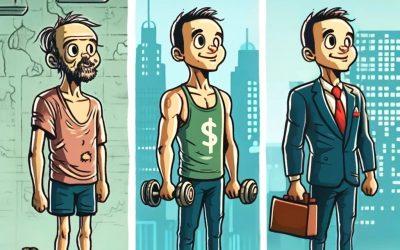So, you’re in your 20s and you want to make a career out of being a Personal Trainer? I mean, a REAL career. Not just something that will cover the cost of your three early morning oat milk macchiatos and smashed avocado on toast, but something that can buy you a house; let you see the world; and give any future kids the financial freedom you never got. A career you’d be proud of.
If you want that, your time is now. Play your card right this decade, and you’ll be set. Go ‘all in’ on the wrong hand however, and you’ll need to find yourself a different game.
Here are the five things you NEED to do in your 20s to really make a go of this PT caper.
First, you need to sample widely.
And this advice flies in the face of the advice I’d usually give. Normally, I urge people to niche down, to find their unique selling proposition and provide it to a narrow and clearly defined client avatar.
And while this is true, it’s less true to someone at the start of their career.
So what does sample widely mean?
It means you should experience as many different training methodologies, styles and approaches as you can. We call this the ‘exploration phase’ of business. You’re exploring options to find what you’re good at, what makes you come alive, and what people will climb over each other to pay you for.
Your wide sampling exploration should be made up of as many ‘Minimal Viable Products’ as possible. An MVP is where you build the absolute basics of a product or service, and put it out into the world to see if the world likes it. Think of these as mini projects – and you should be running one every couple of months. These MVPs are all those little ideas you have in the shower. Explore them all. And sure, you can’t go ‘all in’ on them all, but you can build that minimal viable product. It’ll quickly become obvious which ones have legs.
Once you’ve gone through the exploration phase (which will last years), you can then move into the exploitation phase. This is where you capitalise on the small handful of ideas that have proven themselves successful.
Once you’ve used your 20s to sample widely and moved into the exploitation phase, you have two choices. You can become ten times better at the things you’ve chosen to focus on… or, you can be different. And it’s easier to be different than it is to be ten times better.
As a result of this wide sampling exploration phase, you should exit your 20s as a T-shaped person. Picture a capital letter T. The horizontal cross-beam is a vast reservoir of general knowledge, with the vertical line being a deep understanding and expertise in a specific niche. Ultimately, you can build to a point where you’re using your using your vast breadth of knowledge to solve the problems in your niche in unique ways. These unique ways make you different, which, again, is easier than being ten times better.
Advice number two.
Don’t build a business that solves the problems you have today. Build a business to solve the problems you’ll have in your 30s.
A career needs to solve the problems of the person who has that career.
A young, newly graduated Personal Trainer doesn’t have a lot of financial responsibilities.
Generally, they don’t have kids, they don’t have mortgages, they don’t have bills. They don’t have a lot of financial responsibility. Or if they do, they’re minimal.
So what financial problems does their career need to solve?
Maybe it needs to cover gym rent, food, repayments on a car, socialising, and maybe a Netflix and Spotify subscription. For a lot of people, it doesn’t even need to cover all this.
For a Personal Trainer earning $80,000 a year (about three hours work a day at $100/hour), there’s a nice little profit. A profit that solves all their problems… for now.
The issue is, our problems change.
We’re really bad at picturing ourselves in the future – and even worse at trying to imagine the problems ‘future us’ will have.
The ‘bracketed’ lifestyle of the ‘before work’ clients and the ‘after work clients’, is the ultimate solution to the (currently) limited problems of a young PT. Earn good money, spend the middle of the day at home or the beach. Use that money to spend time with friends, go out on a Saturday night, and generally love life.
But then our priorities change. We buy a property. We get engaged, then married. We have kids.
Our life evolves… but our career doesn’t evolve with it.
We have the life of a 30 year old, with the career designed to solve the problems of a 20 years old.
Work becomes stressful as we realise we need to work more hours. Progressively earlier hours. Progressively later hours.
It doesn’t work. Our career (that was designed to solve a young person’s problems) no longer gives us the life we want. Instead, it detracts from it.
So advice number two is to build a business that solves the problems you’ll have in your 30s, not the problems you’ll have today.
My third piece of advice is to develop an obsessive appetite for consuming content.
In my opinion, a self directed thirst for knowledge outweighs the benefits of a structured, syllabus-driven education. Sure, courses and qualifications have their benefits, but I see them as acting only as the key to the door of your career. They get you through the door, but once you’re in the room, it’s up to you to differentiation yourself.
Spend your 20s reading, watching, listening. Consume content aggressively. Podcasts, audio books, written books, YouTube videos, blogs. Anything and everything you can get your hands on. And I’m not talking ‘fitness specific’ content. I’m talking about ways to further widen the top of the ’T-shaped’ person I was talking about. Instead of listening to yet another podcast on the benefits of periodisation, dive deep into areas like business and psychology.
The key here is to learn by osmosis. Immerse yourself so heavily that the knowledge seeps in whether you like it or not. The authors and podcasters you’re consuming will become your biggest mentors.
So, advice number one was to sample widely, two was to solve the problems of your 30s, and three was to consume obsessively.
My fourth big piece of advice to Personal Trainers in their 20s is to dig the well before you’re thirsty.
What does this mean?
Imagine you’re in the desert, lost and exposed. If you wait until you’re thirsty to start digging for water, you’ve waited too late. Instead, start digging now, so when you get thirsty, you’ll have hit water.
The well you need to dig as a Personal Trainer is your network.
People.
There are two networks to foster.
The first is peers and fellow professionals in your field. Contacts in your own sphere of expertise will help you in the future.
The second network to develop are future potential clients. If you follow my advice to sample widely, you won’t actually know what future products, services and experiences you’ll be selling. People make the mistake of building a business, then searching for the people who need what that business sells. Instead, develop the network first, identify their problems, then build the business that solves these problems.
‘Digging the well’ isn’t just about people though, it’s about brand, reputation and authority. You need to set yourself up as the expert in your field. Then, in the future, you’ll be able to capitalise on your network and your brand with whatever ventures raise their head.
My fifth piece of advice is actually pretty simple.
You need to work hard. Really hard.
This is all about increasing your ‘luck surface area’. There’s so such thing as luck, but the law of averages tells us that if you flip enough coins, eventually you’ll flip ten consecutive heads.
And this hard work isn’t just a series of fleeting short-term bursts of mitigation, it’s a long term commitment. If there is an easier way to achieve success, I haven’t found it. Work harder.
I promised you five pieces of advice… but there’s one more thing I have to mention. It’s not specific to Personal Trainers, but it is vital for your future.
Invest.
The power of investing cannot be understated, particularly for those who earn their income one session at a time.
And the sooner you start, the brighter your financial future.
Find a way to invest $50 per week into a fund mirroring the Australian stock market. If you were to put $50 under your mattress every week for ten years, you’ll end up with $26,000. But, if you instead invest that money, the power of compounding will have turned that money into $35,000. Extend that horizon to 20 years, and instead of just the $52,000 you’ve put aside you’re looking at a sum nudging $130,000. Leapfrog to 30 years, and the $78,000 you’ve put aside is now worth $320,000.
This isn’t just about hoarding wealth; it’s about fostering financial resilience and freedom. In an industry that’s as physically demanding as personal training, you might not always have the luxury of longevity. Investing provides that cushion, ensuring that the sweat of today translates to security tomorrow.
So that’s my advice to PTs in their 20s.
In the dynamic world of personal training, those in their 20s stand at a pivotal point, teetering between immediate passions and long-term sustainability. By focusing on a holistic approach—sampling widely, anticipating future challenges, consuming knowledge, fostering networks, committing to relentless effort, and embracing the wisdom of early investments—young trainers can set the stage for not just a flourishing career but a lifetime of financial security and professional fulfilment. As the journey unfolds, it’s these foundational strategies that will drive your success, guiding you towards success in an ever-evolving industry.





